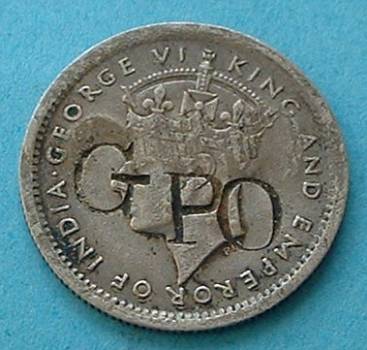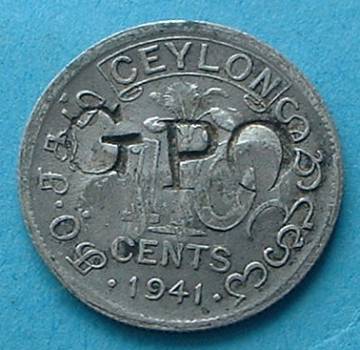| SPECIFICATIONS | |
| Denomination | Ten cents |
| Alloy | Silver |
| Diameter | 15.5 mm |
| Thickness | 0.75 mm |
| Weight | 1.14 gms |
| Shape | Round |
| Edge | Milled |
| DieAxis | O° |


|

|

| ||||||||||||||||||
| Unpublished | ||||||||||||||||||||
Obverse : GPO counter-mark on George VI portrait of silver coin.
Faint mirror impression of reverse countermark.
Reverse : GPO counter-mark on CEYLON 1941 10-cents Talipot palm.
Faint mirror impression of obverse countermark.
This 10-cent coin of the same diameter and weight of the GPO crown token but significantly thinner.
The counter-mark looks unevenly struck. It is likely to have been struck three times on each side since the strike of each letter appears to be at a different angle. Else struck by a CounterStamp made from 3 bound letters which didn't remain perfectly aligned. Don't understand why they would not have cut a counter-mark. Rudi Boekel, secretary of SLNS said he knows of four others in collections and that he too had recently got such a coin struck on both sides from Fred Medis a leading collector in Colombo. According to Medis the armed forces of that time were getting two free local calls per month, paid out with their salaries in the form of two 10 cents countermark coins.
Suddenly many of them are appearing in the numismatic market while none of them have been on major auction for 60 years. Maybe the memorabilia of WWII veterans are droping into the numismatic market as they pass away. Would be interesting to find some mention in some WWII memoirs. The C-M on that older 1928 coin is more even and on one side only.
If this counter-mark is real did it predate the official token. During WWII, 3-month may not been enough time to get the special GPO tokens minted to continue operating the Phone Booths. A counter-mark may have been put on the demonetized 10 cents coins as a temporary measure to make them legal to use as a Phone booth token.
The silver 10 cent coin was demonetized due to decrease in availability of silver and to recover the metal for needs of WWII. These were the last of the silver coins issued into general circulation. There was probably a big tendency for being hoarded for use as temple offerings, a major use of these silver coins even today. Clearly the Phone Booth would continue to work with the unmarked silver coin. Maybe the GPO counter-mark was used on deface these coins to retain just of few of them to operate the phone booths. However surely it would have been a simpler task to make the regular GPO token than to counter-mark these 10-cent coins on both sides for reuse as tokens. Maybe it was a fast measure acceptable since labour was cheap.
The Counter-marked coin is imaged at about 600 dpi and the images are displayed at 400 dpi. These images from an eBay Auction I won in 2004 February.